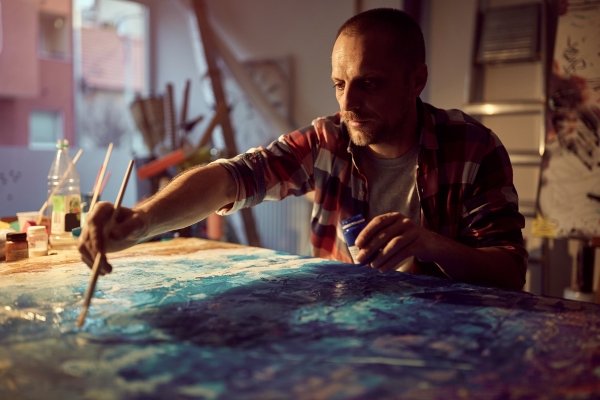Introduction
Welcome to a journey where every canvas transforms into a window into a “wonderful world.” For beginner painters, the process of painting environments is not just about copying what you see—it’s about creating a space that resonates with life, mood, and personal expression. This guide will lead you through the essentials of environment painting, offering techniques, tips, and practical exercises that empower you to bring your artistic vision to life.
Understanding and Observing Your Environment
The first step in painting beautiful environments is observation. Whether you’re drawn to a sunlit forest, a bustling city street, or a quiet room at home, spend time absorbing the details:
- Focus on Atmosphere:
Notice how light interacts with surfaces. Observe the soft glow of early morning light, the dramatic shadows of the afternoon, or the muted hues of twilight. This observation will help you recreate mood and ambiance in your work. - Embrace the Details:
Every space is filled with unique elements—from the texture of a weathered wall to the curve of a gently flowing river. Take quick sketches or notes to capture these nuances. Over time, these details become the building blocks of your composition.
Planning Your Composition
A thoughtful composition is crucial for transforming a simple scene into a compelling artwork:
- Foreground, Middle Ground, and Background:
Divide your canvas into distinct zones. The foreground offers rich details that engage the viewer immediately, the middle ground bridges these elements, and the background recedes into soft focus, enhancing depth. - Choosing a Focal Point:
Identify a key element that will draw the viewer’s eye—this could be a radiant burst of sunlight, an interesting architectural detail, or a naturally framed scene such as an archway or window. - Sketching and Thumbnails:
Before committing to a full painting, create several quick sketches or thumbnail studies. Experiment with different angles and perspectives. These preliminary drawings will guide you when you begin applying paint.
Selecting the Right Tools and Materials
The right tools can elevate your ability to express your vision:
- Brush Selection:
Use a mix of brushes: broad, flat brushes for large washes, and smaller, round or filbert brushes for detailed work. Experiment with different types to discover which ones best suit various elements in your scene. - Choosing a Color Palette:
Whether you prefer a vibrant or subdued palette, consistency is key. Study color theory basics—complementary, analogous, and triadic color schemes—to create harmony in your artwork. Custom mixing your own hues can give your painting a distinctive look.
Mastering Techniques to Capture Light and Mood
Light is the heartbeat of any environment painting:
- Layering and Glazing:
Start with an underpainting to establish tonal values. Then build up layers gradually, using glazing techniques to create luminous effects and subtle transitions between light and shadow. - Dry Brushing and Scumbling:
These techniques help mimic natural textures. Dry brushing can reveal the underlying layers and create a textured finish on surfaces such as tree bark or rough stone. Scumbling, where a lighter, opaque layer is applied over a darker base, can produce soft, diffused transitions. - Perspective and Depth:
Accurate perspective is essential. Use guidelines, grids, or vanishing points to keep your proportions consistent. Experiment with one-point, two-point, or even three-point perspectives to add dynamic depth to your composition.
Practical Exercises for Building Your Skills
Practice is the foundation of improvement:
- Observation Sessions:
Visit different environments—urban, rural, or indoor settings—and take time to sketch the scene. Focus on capturing light, shadow, and form. - Color Studies:
Create small studies where you experiment solely with color. Try replicating the mood of a sunrise, a stormy sky, or a peaceful sunset. This helps you understand how subtle shifts in tone can transform the ambiance. - Texture Drills:
Dedicate sessions to practicing various brush techniques. Work on replicating textures found in nature, such as the delicate pattern of leaves, the rough surface of a brick wall, or the reflective quality of water. - Perspective Challenges:
Pick a scene with multiple elements—such as a cityscape with overlapping buildings or a landscape with a winding path—and practice drawing it from different angles. This exercise sharpens your ability to render complex spatial relationships.
Embracing Mistakes and Evolving Your Style
Remember, each painting is a learning experience. Don’t be discouraged by initial imperfections:
- Learn from Feedback:
Share your work with fellow artists or mentors. Constructive criticism can help you identify areas for improvement and refine your techniques. - Experiment Boldly:
Try new approaches and be open to exploring techniques outside your comfort zone. Over time, these experiments will help you develop your unique artistic voice. - Celebrate Progress:
Compare your early sketches with your more recent work. Notice the evolution in your use of light, color, and perspective. Each piece is a step forward on your creative journey.
Conclusion
Painting wonderful environments is about capturing the essence of a scene while expressing your unique perspective. With careful observation, strategic planning, and persistent practice, you can transform everyday spaces into vibrant, immersive worlds on canvas. Remember that every brushstroke is an opportunity to experiment, learn, and ultimately create a piece that not only depicts a scene but also evokes emotion and wonder. Embrace the journey with patience and passion, and soon you’ll find that the wonderful worlds you create are limited only by your imagination. Happy painting!


